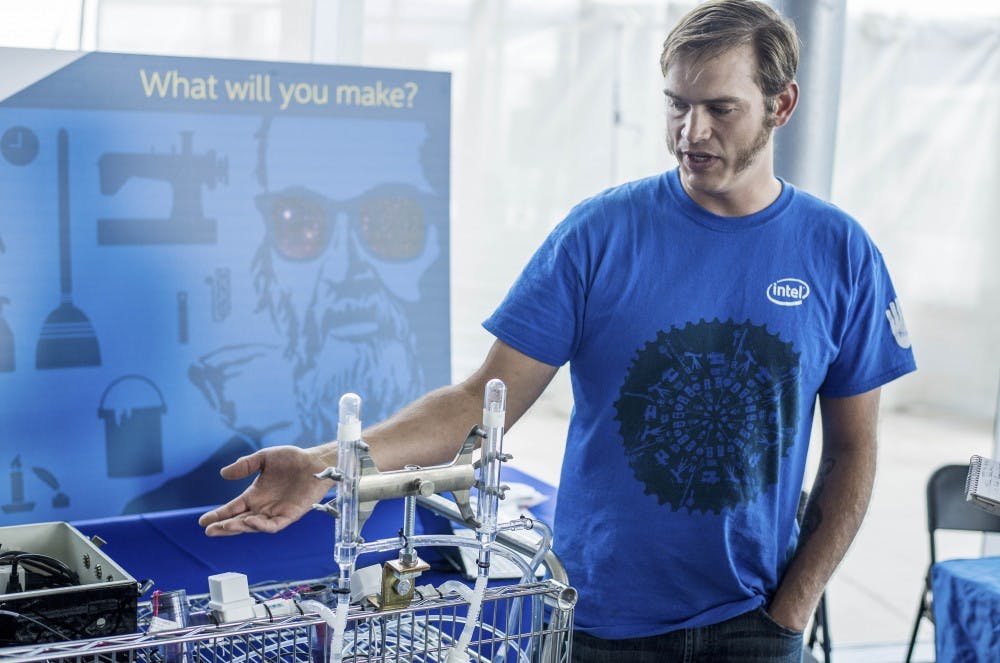The Albuquerque Balloon Museum housed the faire with more than 100 different projects Saturday and Sunday, each one with a creative, artistic and innovative twist.
Christian Ristow, a multimedia artist and machinist, said he has a reputation for large metal-mechanical sculptures. His piece titled “Face Forward” requires multiple users to engage with it in order to make the face move, he said.
“I built this in about three months,” Ristow said. “My work is always envisioned. I got interested, at a certain point, in human musculature, and the fact that we have this very intricate, sensitive muscle that is mostly for communication.”
This is not the first time Ristow has referenced the human form in his work, he said. At last year’s Mini Maker Faire he constructed a 26-foot-long mechanical hand, “The Hand of Man,” and has recently done several small self-portraits.
“As a sculptor I am always trying to figure out what I want to build,” Ristow said. “One way to answer that question is ‘what other work do I see that I like, that I care about.’”
In his 20s Ristow recognized his unending desire to build and constructed his work based on what he wanted to see, he said. He started with small robots and mechanical insects; eventually he started creating large-scale kinetic pieces.
Ristow travels internationally with his work and attends the annual Maker Faire in San Mateo, California, he said.
“I design things with an awareness of how I am going to move them later,” Ristow said.
Amber Williams, curator of the Mini Maker Faire, said New Mexico’s faire is a smaller version of the one in San Mateo, which started in 2009.
“The ‘mothership festival’ happens in San Mateo, and then all across the world they do more of these mini versions,” Williams said.
The great thing about having a mini faire here is that people can bring pieces of the larger festival in California to local people who can’t make it out there, she said. Anyone who has an idea and wants to show it is welcome to display their work at the faire.
Get content from The Daily Lobo delivered to your inbox
“What we ask of our makers is that you have some sort of an aspect that people can participate with hands-on,” Williams said. “So you can come and display your stuff, but we want you to also have some sort of interaction with the folks ... we want people to engage in what’s happening here, not just come and look.”
Roughly 2,500 people attended this year’s event — 500 more than last year, she said. Plus, this year’s faire featured 25 more makers than the previous year.
Dan McCulley, an Intel researcher of manufactured products, said Intel started with an internal maker faire in October with the Galileo board until they launched the Galileo Project.
“What we are trying to do is make it easier for makers to make,” McCulley said. “What’s interesting about what Intel is offering to makers is a web server on one side, plus a physical computer on the other, so it can make the lights go blinky-blinky, and I can do all that from the web.”
The Galileo board is available to the public, he said. Intel has also donated more than 1,000 boards to local colleges, including CNM and NMSU.
“There are about 10 makers and 15 volunteers that are here today with Intel,” McCulley said.
To demonstrate the Galileo board at work, users have a temperature sensor example that attendees can actually play with, he said. On display was also an Augmented Reality Sandbox that used Intel’s technology.
McCulley said a company in Santa Fe, Sims Tables, sells the sandboxes complete with the projector and specific software for about $20,000 apiece.
“They use it to fight forest fires here in the state,” McCulley said. “You put a real topographic map, where the forest fire is, and you build the sand to match the real map. You can set real fires in the simulation where the fire actually is, and plan what your firefighters are going to do and save lives, faster evacuations.”
Janet Scholar, a software engineer at Intel, said the sandbox exhibit helps educate students on water movement and study of the land.
“A Kinect sensor from the Xbox takes a 3D model of the sand and sends it to the computer,” Scholar said. “Then it computes the topology of the sand’s surface and projects it on a 2D monitor, and then it’s connected to a projector that gets projected right back on the sand.”
The image is rendered at 30 frames per second on special sand, she said. A lot of museums back east are implementing the sandbox for a hands-on experience.
Moriah Carty is a staff reporter for the Daily Lobo. She can be reached at culture@dailylobo.com or on Twitter @MoriahCarty.






